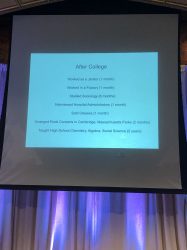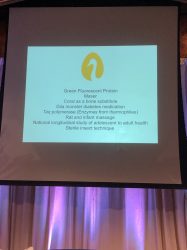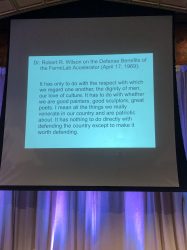On Friday, Teachers College’s EPIC (Education for Persistence and Innovation Center) kicked off their Yu Panglin Lecture Series with “Failing Upward: The Open Secret of Progress in Science with Nobel Laureate Martin Chalfie and Maiken Scott.” Dr. Chalfie spoke about his college grades, glowing proteins, and more. Staffer Sarah Braner has the scoop.
It might seem disingenuous for a Nobel laureate to call himself “failed and useless.” But that’s exactly how Martin Chalfie, recipient of the prize in Chemistry (along with Osamu Shimomura and Roger Tsien) in 2008 for his work with green fluorescent protein (GFP) kicked off his lecture on failure and success. After some opening remarks by Dr. Xiaodong Lin-Siegler (founder and chairperson of EPIC), Thomas Bailey (Teacher College President) and Dennis Pang (chairman of Yu Panglin Charitable Trust), Chalfie started by noting that he slept through the phone call from the Nobel Prize committee and showing his college transcript. (Notably, there wasn’t a single grade above a C in chemistry.) Many of his early experiments failed because, he said, “I had decided that real scientists never asked for help.” This would become a guiding theme for the afternoon – that trying to emulate the stories we hear of “real scientists” is often detrimental to our own success.
Common elements of these stories include that scientists are geniuses (and that ability is innate), that their experiments work all the time, that they always use the scientific method and are purposeful in doing so, that they work alone (though sometimes assistants are allowed), and that they are all white men (“except for Marie Curie and George Washington Carver”). However, the story of GFP provided a counterexample.
- Another myth debunked: that scientists always go to grad school right after college.
The story starts with Osamu Shimomura, a Japanese scientist studying bioluminescence in animals, trying to isolate the cells that made jellyfish glow green. After a day of failed attempts, he cleaned up his station, tossed his samples into the sink (which contained seawater) and prepared to leave the lab, but after turning the lights off and glancing once more at the lab, he noticed the sink was glowing. This led him to realize that something in the seawater was the key to making the cells glow: calcium. “Not exactly the scientific method.” The only problem was that the light was the wrong color – it was supposed to be green, but his cells glowed blue. So, maybe there was something that converted the blue to green. This led to the discovery that there was a protein that, when blue light was shone upon it, it glowed green.
Chalfie learned about this in one of his seminars and realized that you didn’t need the rest of the cell – all you needed was the protein. If one put this protein into the cells they studied and shone blue light on it, only the transformed cells would glow green. “If you can see something, you can study it.” This led to scientists being able to label and track cells, with huge ramifications for research. Applications include tagging and studying proteins coming out of solution in cell cytoplasms (particularly relevant in Alzheimer’s disease), tagging HIV virions to find out how they spread from cell to cell, and, my personal favorite, having bacteria produce GFP in the presence of TNT. While this may seem “useless”, TNT is actually leaked out by unexploded land mines – so this method may be used to detect them without putting people in danger one day. (This technique is still in development, as it doesn’t work 100% of the time.) None of this would have been possible if not for the repeated failure of Shimomura. (Roger Tsien also received the Nobel for work with GFP – he adapted it to glow different colors, so scientists can tag multiple different things and keep track of them.)
Chalfie then used the GFP story to refute some of the wrong dogmas he had learned in the past. Scientists are not all geniuses, and the ones that are aren’t so all the time. Scientists’ experiments rarely work. Scientists rarely use the scientific method purposefully, and they usually do this after a discovery. Scientists rarely work alone. And to the claim that science is done by white men? “Nonsense.”
The “useless” nature of bacteria producing GFP in response to TNT actually led into another, secondary theme of the lecture – the need for useless knowledge. This technique for tagging cells and proteins was revolutionary, but Shimomura’s research seemed useless at the time. Chalfie also noted that this happens all the time – discoveries thought to be useless turn out to be incredibly important. This led to mentioning the “Golden Goose Award”, which “highlights and honors examples of scientific studies or research that may have seemed obscure, sounded ‘funny’, or for which the results were totally unforeseen at the outset, but which ultimately led, often serendipitously, to major breakthroughs that have had significant societal impact.” Shimomura, Chalfie, and Tsien received the award for GFP, but other laureates include coral as a bone substitute and gila monster diabetes medication. All of this led to the point that useless knowledge is necessary if we want to produce useful knowledge.
- Past recipients of the Golden Goose Award
- Chalfie’s favorite quote on “useless knowledge”
While Chalfie had to cut his lecture short due to time constraints, there was time for a brief Q&A, moderated by Maiken Scott (host of WHYY‘s The Pulse).
One question asked how Chalfie guides his students through failure, to which he responded, “giving up is the problem.” He stressed the importance of working on more than one project in the lab, though he noted that this isn’t always what a grad student wants to hear. (“You’re failing? Do more!”)
Another centered on scientist’s expectations of themselves – Scott noted that “scientists think they’ll do the next big thing… and just being part of the journey feels like failure.” Chalfie said that, again, part of the problem is how we tell the stories of these breakthroughs. If we’re trying to be the first person to do a thing, failure is in an inevitable part of that. “Because we don’t know what we’re doing. If we did, we’d solve it.”
Finally, the last one asked for his advice for aspiring Nobel laureates. The first part of his answer was “don’t try to get a Nobel Prize.” He noted that the prize was odd in that it doesn’t go to the best scientists, it goes to those who whose work changes science. This work comes from accidental discoveries, and you can’t design how to accidentally discover something. But to be the best scientist you can be, you have to “put in the work. These accidental discoveries only happen if you do the experiments.”
Edit 3/7/19, 1:13 pm: An earlier version of this post listed Teachers College as “Teacher’s College.” Corrective edits have been made accordingly.


 3 Comments
3 Comments



3 Comments
@Anonymous Cheers to Nobel Laureate Chalfie for telling the TRUTH. May we all be inspired…..
Great taglines by bwogger Sarah Braner
@Anonymous good read, ty early-2019 braner
@Anonymous Wow, I feel like I was at the lecture! Great Summary